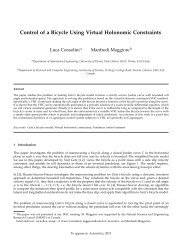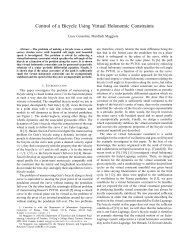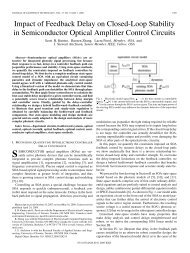State Based Control of Timed Discrete Event Systems using Binary ...
State Based Control of Timed Discrete Event Systems using Binary ...
State Based Control of Timed Discrete Event Systems using Binary ...
Create successful ePaper yourself
Turn your PDF publications into a flip-book with our unique Google optimized e-Paper software.
Chapter 5. BDD based implementation 35[30], which is many times faster and smaller in the sense <strong>of</strong> memory usage than TCT.STCT does not need an exhaustive list <strong>of</strong> the entire state space and thus is able to achievea performance far beyond that <strong>of</strong> TCT.For a timed model this complexity problem is more critical, because as we saw in the previoussection state explosion is much faster in untimed models than timed ones. Clearlyfor large systems an exhaustive list <strong>of</strong> the entire state space cannot be used.5.3 Converting ATG to TTGConstructing the TTG from the ATG <strong>of</strong> the TDES is based on the definition <strong>of</strong> δ(q, σ).Actually we should find the reachable states <strong>of</strong> the TDES. As we saw in chapter 2, eachstate <strong>of</strong> the TDES has two kinds <strong>of</strong> component: activity and timer <strong>of</strong> each event. Thuseach state would be an n + 1 tuple, where n is the number <strong>of</strong> events in the system.The natural way to find these states is to start from the initial state q 0 = (a 0 , {t σ,0 |σ ∈Σ act }) where⎧⎪⎨ u σ ,t σ,0 =⎪⎩ l σ ,if σ ∈ Σ speif σ ∈ Σ remand find the reachable states by the rules given in the definition <strong>of</strong> δ. In this method,we should go through all the states and check the conditions to find the next states inthe graph. If the time bounds <strong>of</strong> events are big, the number <strong>of</strong> states will be much bigger.Using this exhaustive search method would not be efficient and fast. Additionally,<strong>using</strong> the tables for storing these states would be much too memory-consuming. Insteadwe convert the rules for defining the transitions in TDES to logical operations that canbe applied to predicates. By these logical operations, all the possible transitions in thesystem which satisfy the rules, can be found in the form <strong>of</strong> predicate. After finding thetransition predicates, the reachable states can be found by applying suitable logical operationsas we will discuss later.







